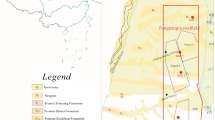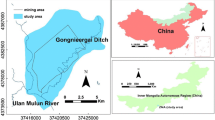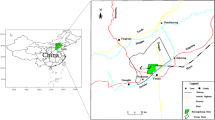Abstract
Coal mining can seriously affect groundwater systems in aquifers that overlie the coal seam, especially in dry and water-stressed areas where protection of groundwater resources is very important. Through generalization of the hydrogeological conditions and analysis of the actual groundwater flow field in a confined weathered bedrock aquifer overlying the Shennan mining area in northern Shaanxi, a hydrogeological conceptual model and numerical groundwater flow model were established. FEFLOW finite element software was used to solve the model and dynamic groundwater data were used to validate it. The study area was hydrogeologically modeled by repeatedly adjusting the parameters. The model was then used to simulate the effect of mining on the overlying aquifer based on the mining plan for the next 5 years by adjusting the quantity of water discharged, the hydrogeological parameters of the upper water-bearing zone, the characteristics of the groundwater flow field, and the predicted water balance after 5 years. The results show that the maximum drawdown could be as high as 50 m (northeast of the Zhangjiamao Mine). A cone of depression centered on the Ningtiaota, Zhangjiamao, and Hongliulin mines will be formed that will influence more than 75% of the simulation area.
Zusammenfassung
Der Abbau von Kohle unter Grundwassersystemen in Aquiferen kann beträchtliche Auswirkungen haben, besonders in trockenen und wasserarmen Landschaften, in welchen der Schutz von Grundwasserressourcen sehr wichtig ist. Mittels einer Generalisierung der hydrogeologischen Randbedingungen und einer Analyse des derzeitigen Grundwasserfließfeldes in einem begrenzten Aquifer verwitterter Festgesteine über den Shennan Kohleflözen wurden ein hydrogeologisches konzeptuelles Modell und ein numerisches Grundwasserfließmodell erstellt. Digitalisierung und Berechnungen erfolgten in FEFLOW. Dynamische Grundwasserdaten wurden zur Validierung verwendet. Wiederholte Adjustierung der Parameter diente der Optimierung des Modelles. In der Folge wurde das Modell zur Simulation der Auswirkungen des Kohleabbaues nach dem Bergbauplan für die nächsten 5 Jahre eingesetzt, indem das geförderte Wasservolumen, die hydrogeologischen Parameter der wasserführenden Zone, die Charakteristika des Grundwasserfließfeldes und die Wasserbilanz nach 5 Jahren adjustiert wurden. Die Resultate zeigen, daß die maximale Absenkung 50 m erreichen könnte (nordöstlich der Zhangjiamao Mine). Ein Absenkungstrichter, welcher mehr als 75% des Untersuchungsgebietes betreffen wird, entsteht zentriert über den Minen Ningtiaota, Zhangjiamao und Hongliulin.
抽象
煤炭开采可能破坏煤层上覆含水层地下水系统,尤其在干旱缺水区情况更加严重。通过归纳水文地质条件和分析陕北神南矿区风化基岩承压含水层地下水流场,建立了矿区水文地质概念模型和数值模型。应用FEFLOW有限元求解模型,动态地下水位检验模型,重复调参建立矿区水文地质模型。采用调整矿区排水量、上覆含水层水文地质参数、地下水流场特征和五年后预测水均衡的方法,预测了下个五年回采计划对矿区含水层影响。结果表明:最大降深达50m(张家峁东北),以拧条塔矿、张家峁矿和红柳林矿为中心的降落漏斗将涉及75%矿区范围。
Resumen
La minería de carbón puede afectar seriamente los sistemas de aguas subterráneas en acuíferos que bordean la veta de carbón, especialmente en áreas secas y pobres en agua donde la protección de los recursos de aguas subterráneas es muy importante. Se establecieron un modelo conceptual hidrogeológico y un modelo numérico de flujo del agua subterránea a través de la generalización de las condiciones hidrogeológicas y el análisis del campo de flujo de aguas subterráneas en un acuífero confinado en un lecho de rocas, bordeando el área minera Shennan en el norte de Shaanxi. El software de elemento finito FEFLOW se usó para resolver el modelo y los datos dinámicos de aguas subterráneas fueron usados para validarlo. El área de estudio fue modelada hidrogeológicamente por sucesivos ajustes de los parámetros. El modelo fue posteriormente usado para simular el efecto de la minería sobre el acuífero basado en el plan de explotación minera para los próximos cinco años por ajuste de la cantidad de agua descargada, los parámetros hidrogeológicos de la zona superior del agua, las características del campo de flujo del agua subterránea y el balance de agua predicho para después de cinco años. Los resultados muestran que el máximo descenso podría ser de hasta 50 m (en el noroeste de la mina Zhangjiamao). Un cono de depresión centrado en las minas Ningtiaota, Zhangjiamao y Hongliulin se formará e influirá sobre más del 75% del área de la simulación.








Similar content being viewed by others
References
Bian H (2014) Numerical simulation study on the impact of water conservation under coal mining a case study of Yushen Mine in third-stage mining. Chang’an University, Xi’an (in Chinese)
Chang J, Li W, Li T, Du P (2011) Zonation of water resources leakage due to coal mining in Shennan mining area. Coal Geol Explor 39(5):41–45 (in Chinese)
China Geological Survey (2012) Handbook of hydrogeology, 2nd edn. Geological Publishing House, China, pp 128–129 (in Chinese)
Dong D, Sun W, Xi S (2012) Optimization of mine drainage capacity using FEFLOW for the no. 14 coal seam of China’s Linnancang coal mine. Mine Water Environ 31:353–360
Guo W, Zhao J, Yin L, Li Y, Zhang B, Lu C (2015) Influences of water pressure and advance length on floor water inrush based on mechanism of fluid–solid coupling. Electron J Geotech Eng 20(7):1947–1956
Kim JM, Parizek RR (1997) Numerical simulation of the Noordbergum effect resulting from groundwater pumping in a layered aquifer system. J Hydrol 202(1):231–243
Li SG, McLaughlin D, Liao HS (2003) A computationally practical method for stochastic groundwater modeling. Adv Water Resour 26(11):1137–1148
Ministry of Health (Ministry of Health of the People’s Republic of China, Standardization Administration of the People’s Republic of China) (2006) Standards for drinking water quality (GB5749-2006). Standards Press of China, Beijing (in Chinese)
Scheibe T, Yabusaki S (1998) Scaling of flow and transport behavior in heterogeneous groundwater systems. Adv Water Resour 22(3):223–238
Sun W, Wu Q, Dong D, Jiao J (2012) Avoiding coal–water conflicts during the development of China’s large coal-producing regions. Mine Water Environ 31(1):74–78
Surinaidu L, Rao VG, Rao NS, Srinu S (2014) Hydrogeological and groundwater modeling studies to estimate the groundwater inflows into the coal mines at different mine development stages using MODFLOW, Andhra Pradesh, India. Water Resour Ind 7–8:49–65
Wang H, Jiang Z (2011) Analysis of groundwater resources and mining effect in Shennan mining area of China. Shaanxi Coal 30(5):1–4 (in Chinese)
Wang W, Li Z, Zhang P (2004) Environmental disaster issues induced by coal exploitation in Shenfu-Dongsheng coal field. Chin J Ecol 23(1):34–38 (in Chinese)
Wang L, Wei S, Wang Q (2008) Effect of coal exploitation on groundwater and vegetation in the Yushenfu coal mine. J Chin Coal Soc 33(12):1408–1414 (in Chinese)
Wu Q, Wang M, Wu X (2004) Investigations of groundwater bursting into coalmine seam floors from fault zones. Int J Rock Mech Min Sci 41(4):557–571
Wu X, Li H, Dong Y, Liu T (2014) Quantitative identification of coal mining and other human activities on river runoff in northern Shaanxi region. Acta Sci Circum 34(3):772–780 (in Chinese)
Ye G, Zhang L (2000) The main hydro-engineering-environmental–geological problems arose from the exploitation of coal resource in Yu-Shen-Fu mine area of northern Shaanxi and their prevention measures. J Eng Geol 8(4):446–455 (in Chinese)
Zhang F, Liu W (2002) A numerical simulation on the influence of underground water flow regime caused by coal mining—a case study in Daliuta, Shenfu mining area. J Safety Environ 2(4):30–33 (in Chinese)
Zhang S, Ma C, Zhang L (2011) The regulators of runoff of the Ulan Moron River in the Daliuta mine area: the effects of mine coal. Acta Sci Circum 31(4):889–896 (in Chinese)
Acknowledgements
The authors thank everyone who provided assistance for the present study. This study was jointly supported by the National Key Basic Research and Development Program of China (973 Program, Grant 2015CB251601) and the State Key Program of National Natural Science of China (Grant 41430643).
Author information
Authors and Affiliations
Corresponding author
Electronic supplementary material
Below is the link to the electronic supplementary material.
Rights and permissions
About this article
Cite this article
Xie, P., Li, W., Yang, D. et al. Hydrogeological Model for Groundwater Prediction in the Shennan Mining Area, China. Mine Water Environ 37, 505–517 (2018). https://doi.org/10.1007/s10230-017-0490-0
Received:
Accepted:
Published:
Issue Date:
DOI: https://doi.org/10.1007/s10230-017-0490-0




